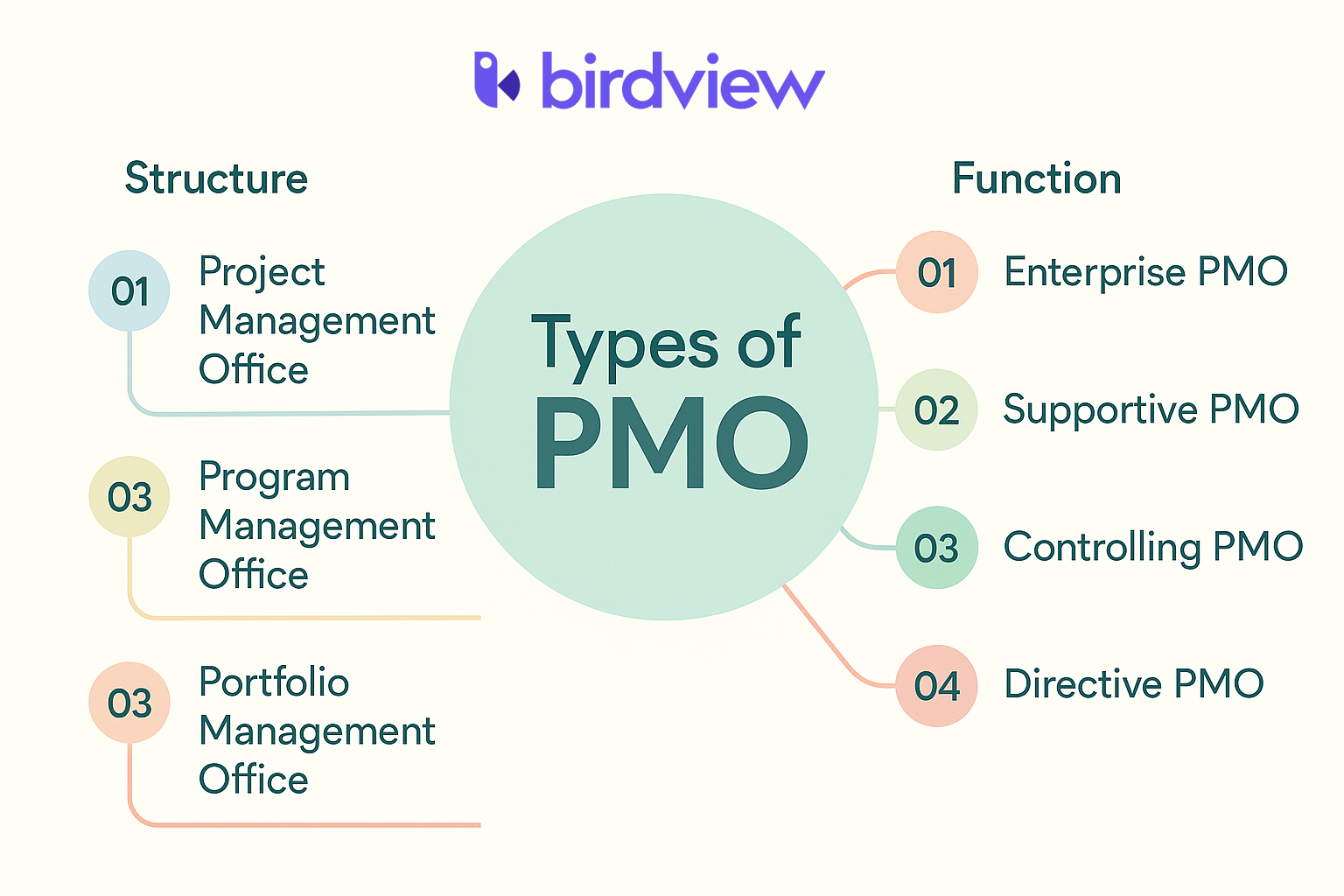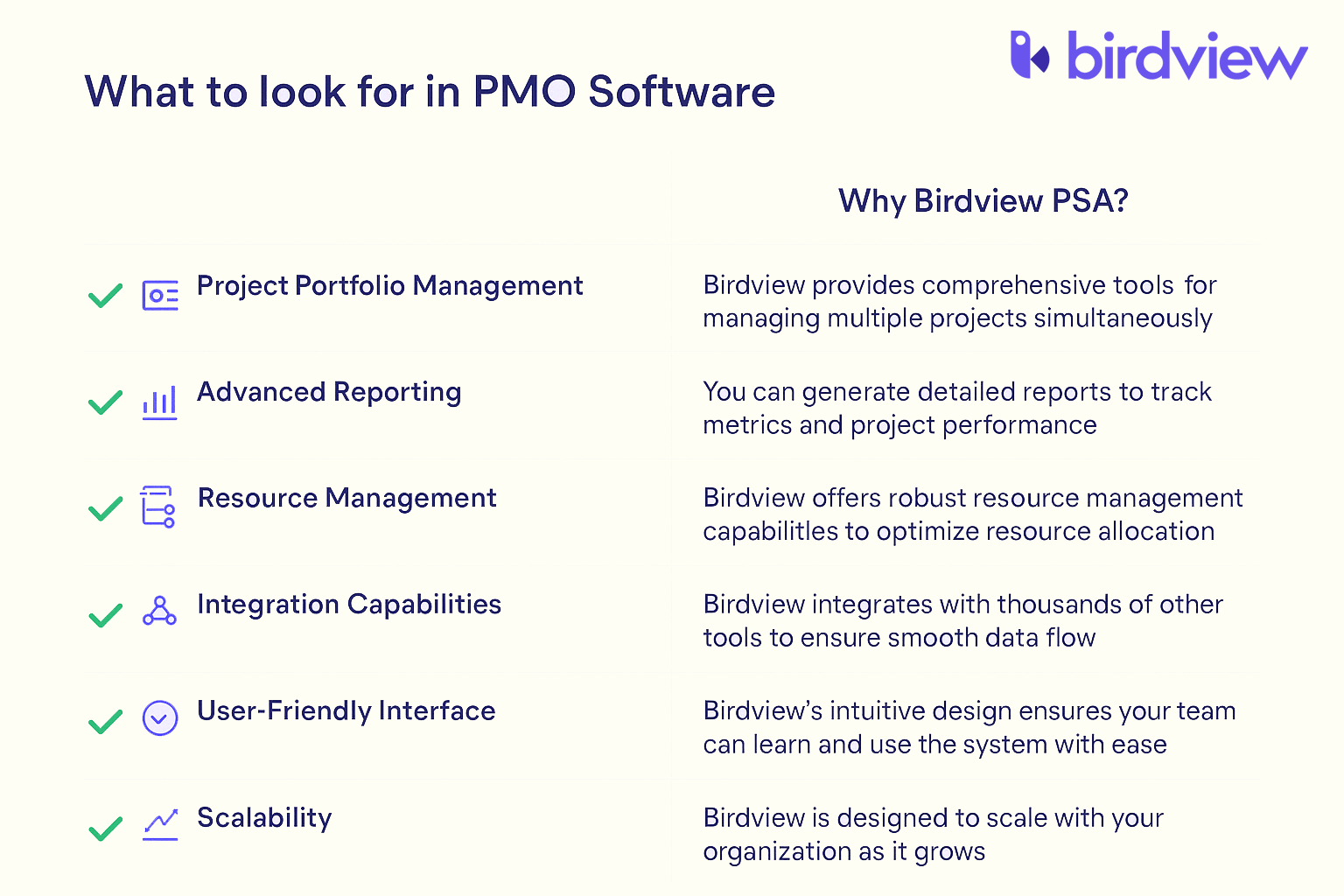Whether you’re new to the concept of a project management office (PMO) or looking to enhance your existing PMO practices, this guide is here to provide you with valuable insights and practical tips. A well-implemented PMO can be a game-changer, driving efficiency, consistency, and success across your projects.
What is a PMO?
A project management office (PMO) is a team or department that defines and maintains project management standards across an organization. Its goal is to bring consistency, structure, and oversight to how projects are planned, executed, and delivered. PMOs can be internal (within the organization) or external (outsourced), and they may vary in scope and function depending on business needs.
Structure PMO
There are different types of PMOs, each serving a distinct purpose:
-
Project Management Office focuses on supporting individual projects. It provides tools, templates, and administrative assistance, helping project teams follow consistent practices.
-
Program Management Office oversees groups of related projects (programs). It manages governance, aligns project efforts, and ensures the program delivers value as a whole.
-
Portfolio Management Office takes a broader view, managing the full portfolio of projects and programs. It aligns initiatives with strategic priorities and ensures resources are invested in the right areas.
Each type plays a different role, but all are designed to help organizations deliver projects more efficiently and strategically.

Types of PMO based on function
PMOs can vary widely in their scope, responsibilities, and authority. Before setting up a project management office within your organization, it is important to identify the specific needs and objectives you are aiming for. This information will help you choose the right type of PMO for your team. Let‘s have a closer look at each type of project management office.
👉 01. Enterprise PMO (EPMO)
An Enterprise Project Management Office (EPMO) operates at the highest strategic level within an organization. Unlike traditional PMOs that focus on individual projects or departments, the EPMO is responsible for aligning all project, program, and portfolio activities with the organization’s overall business strategy and objectives.
The EPMO plays a central role in decision-making, governance, and performance measurement across the entire project landscape. It acts as a bridge between executive leadership and project execution teams, ensuring that every initiative contributes to long-term goals and delivers measurable value.
Key characteristics of Enterprise PMO:
✔️ Strategic Alignment: The EPMO ensures that project portfolios are prioritized based on their alignment with corporate goals, resource capacity, and expected return on investment (ROI).
✔️ Enterprise-Wide Governance: Establishes consistent governance structures, reporting standards, and risk management practices across all departments and business units.
✔️ Cross-Department Collaboration: Coordinates efforts across functions (e.g., IT, HR, Finance, Engineering) to eliminate silos and promote unified execution.
Read more: Managing cross-functional teams in organizations: best practices
✔️ Performance Monitoring: Tracks KPIs at the organizational level and provides insights to leadership through dashboards and executive reports.
✔️ Change Enablement: Supports organizational change management initiatives and helps drive enterprise-wide transformation programs.
Typical functions of Enterprise PMO:
- Managing enterprise-level project portfolio selection and prioritization
- Enforcing governance standards across all PMOs or project teams
- Aligning resource allocation with strategic priorities
- Advising executives on investment trade-offs and capacity planning
- Driving process improvement and PM maturity across the organization
An EPMO is most valuable in large, complex organizations with multiple departments running simultaneous projects. It becomes essential when leadership needs better visibility into project outcomes, tighter alignment with business strategy, and centralized control over enterprise resources and risks.
👉 02. Supportive PMO
A Supportive PMO serves as a resource hub, offering best practices, templates, training, and guidance–while allowing teams to manage projects independently. It has minimal control, making it suitable for organizations with low project management maturity.
Typical functions:
- Maintaining a project knowledge base
- Providing training and coaching
- Creating standardized templates and tools
👉 03.Controlling PMO
This type provides both support and governance by enforcing standard methodologies, tools, and documentation. It offers moderate oversight and is ideal for organizations seeking consistency across projects.
Typical functions:
- Standardizing processes and tools
- Requiring compliance with reporting and documentation standards
- Conducting audits and performance reviews
👉 04. Directive PMO
A Directive PMO takes full control of project execution. Project managers report directly to the PMO, which oversees budgets, schedules, and resources. This model suits organizations running high-stakes, strategically critical projects.
Typical functions:
- Assigning and managing project teams
- Controlling budgets and timelines
- Making key decisions on priorities and resource use
What is a project management office (PMO)?
A Project Management Office (PMO) is a centralized group or department within an organization that defines and maintains project management standards and practices. It provides oversight, governance, and support to ensure that projects are delivered effectively, efficiently, and in alignment with business objectives.
Depending on the organization’s size and maturity, a PMO can range from a small team supporting a few projects to a large strategic entity that oversees a company-wide portfolio.
A Project Management Office (PMO) is a central hub that helps organizations manage projects efficiently and align them with business goals. Whether in a small company or a large enterprise, a PMO plays a key role in improving project success.
Key roles and responsibilities of a PMO
A PMO is more than just a department–it‘s the driving force behind effective project execution. By offering a structured framework, a professional services PMO ensures that projects are aligned with strategic goals, managed efficiently, and focused on delivering value.
At its core, the PMO exists to provide structure, promote best practices, and ensure strategic alignment across all projects. Below are its key roles and responsibilities:
PMO roles explained
✔️ PMO Director
The strategic leader of the PMO. Sets the vision, aligns project portfolios with business goals, and reports to the C-suite. Owns PMO performance, governance standards, and cross-departmental coordination.
✔️ PMO Manager
Oversees day-to-day PMO operations. Manages staff, ensures project governance is followed, and supports project managers in delivery and reporting. Bridges the gap between strategy and execution.
✔️ PMO Analyst
Focuses on data. Tracks KPIs, builds dashboards, analyzes project performance, and supports reporting to leadership. Helps identify trends, risks, and improvement opportunities.
✔️ PMO Consultant
An external or internal advisor who assesses PMO maturity, recommends improvements, and helps implement tools, frameworks, or transformations. Often brought in during scaling or change initiatives.
✔️ PMO Administrator (or Coordinator)
Handles administrative tasks like maintaining project documentation, updating schedules, booking meetings, and managing tools. Provides essential support to keep PMO operations smooth and organized.
Additional roles (Optional or Scaled)
✔️ Portfolio Manager
Manages multiple projects or programs across business units. Prioritizes based on ROI, capacity, and strategic fit.
✔️Project Controller
Focuses on financials: budgeting, forecasting, cost control, and ensuring financial accuracy at the project level.
✔️ Resource Manager
Allocates people across projects based on availability, skills, and workload. Works closely with PMs to avoid bottlenecks or underutilization.
✔️ Tool/System Administrator
Maintains and configures the PMO‘s software stack (e.g., PSA, PPM, reporting tools). Ensures integrations work smoothly and users are supported.
PMO Responsibilities
✔️ Standardization of Processes
The PMO develops and implements project management frameworks, methodologies (such as Agile, Waterfall, or hybrid), and templates. Its goal is to ensure consistency in planning, execution, and reporting across all projects.
✔️ Project Governance and Compliance
It sets clear guidelines for project approvals, change control, and escalation paths, while monitoring compliance with both internal policies and external regulations.
✔️ Resource Management
The PMO allocates resources across projects based on availability, skillsets, and strategic priorities. It also tracks capacity and utilization to improve efficiency and avoid bottlenecks.
Read more: Resource Management in Project Management: Process, Tools
✔️ Portfolio Management
Responsible for overseeing the full project portfolio, the PMO ensures alignment with business objectives. It evaluates, prioritizes, and monitors projects based on value, risk, and return on investment.
Read more: What is Project Portfolio Management (PPM) | Birdview PSA
✔️ Performance Monitoring and Reporting
It defines success metrics and KPIs, then delivers dashboards, status reports, and performance summaries to stakeholders for informed decision-making.
✔️ Support and Training
The PMO offers coaching, training, and mentorship to project managers and teams, and supports the tools and systems that enhance execution and collaboration.
✔️ Risk and Issue Management
It identifies risks early, develops mitigation plans, and facilitates resolution of issues, ensuring project stability and continuity.
Benefits of a Project Management Office (PMO)
A PMO acts as a strategic guide, helping projects start strong and finish successfully. One of its core benefits is improving project success rates by enforcing standardized processes and ensuring proper planning and execution. It also enhances resource efficiency by optimizing the use of time, people, and budget across projects.
Risk management is another key advantage. The PMO helps identify and mitigate risks early, reducing disruptions and promoting smoother delivery. It also strengthens strategic alignment by ensuring all projects support the organization‘s broader goals.
With centralized data and reporting, a PMO enables better decision-making by giving leaders the insights they need to act effectively. It promotes consistency in project delivery through repeatable processes, improving both reliability and quality.
The PMO also increases accountability by making project progress and responsibilities visible to all stakeholders. As a result, customer satisfaction improves, with projects delivered on time, on budget, and to expectations–ultimately boosting the organization’s reputation and impact.
Best PMO techniques
A well-functioning Project Management Office (PMO) is more than a governing body–it‘s a strategic partner that enables consistent project delivery, cross-functional alignment, and portfolio-level visibility. To maximize its impact, a PMO must implement proven techniques that promote efficiency, adaptability, and accountability.
1. Standardized Methodologies
Establishing and enforcing consistent project management methodologies (e.g., Agile, Waterfall, or hybrid) ensures teams follow structured processes. This improves predictability, quality, and comparability across projects.
2. Portfolio Prioritization
Use objective criteria to evaluate and rank projects based on business value, risk, resource requirements, and strategic fit. This allows leadership to allocate resources effectively and focus on the most impactful initiatives.
Read more: 4 Essential Steps of Project Portfolio Optimization
3. Centralized Reporting and Dashboards
Provide stakeholders with real-time dashboards that show project status, risks, and performance metrics. Tools like BI-powered reports help surface issues early and support informed decision-making.
Read more: Project Dashboards: types, examples, and benefits
4. Capacity and Resource Management
Track team capacity, skills, and availability across the organization. Assign resources based not just on availability, but also alignment with project needs and long-term planning.
Read more: What is Resource Capacity Management
5. Stage-Gate Governance
Implement formal review checkpoints at key stages of the project lifecycle. These checkpoints ensure scope, budget, and risk are assessed before moving forward–reducing project failure rates.
6. Knowledge Management
Document lessons learned, templates, workflows, and best practices in a central repository. This institutional knowledge helps future projects avoid repeated mistakes and ramp up faster.
7. Change Control Process
Introduce a structured change management process to assess the impact, cost, and necessity of change requests. This minimizes scope creep and protects project timelines and budgets.
8. Stakeholder Engagement
Establish consistent communication plans and feedback loops with key stakeholders. Regular updates and two-way communication help build trust and maintain alignment.
9. PMO Maturity Assessments
Conduct periodic evaluations of your PMO‘s performance and influence. Use maturity models to identify strengths, gaps, and opportunities for growth.
10. Tool Integration
Ensure your PMO integrates with enterprise tools–like ERP systems, CRM platforms, and time tracking tools–to reduce duplication and improve data accuracy.
Using PMO in the services industry
In the services industry–where client relationships, time management, and delivery quality are key–a Project Management Office (PMO) plays a vital role in ensuring consistency, transparency, and profitability across projects.
Why a PMO matters in services
A PMO in professional services plays a critical role in driving operational efficiency and profitability. It enforces standardized delivery frameworks to ensure consistency across client projects, while optimizing time and resource management–crucial in firms where every hour is billable. By centralizing communication, the PMO enhances transparency and trust with clients. It also tracks project financials closely, monitoring budgets and margins to protect profitability, especially under SLA-driven contracts. Finally, through process refinement and knowledge sharing, the PMO fosters continuous improvement across engagements.
PMOs are widely used in service-focused sectors such as:
-
IT services (software delivery, managed services, DevOps)
-
Engineering & architecture firms
-
Marketing & creative agencies
-
Legal, financial, and consulting services
Read more: Best Consulting Project Management Software
In the services industry, a PMO isn’t just a back-office function–it‘s a strategic partner that ensures smooth execution, better client outcomes, and stronger business performance.
🔍 How to choose the right PMO software
Choosing the right PMO software is critical to the success of your Project Management Office. It‘s not just about managing projects–it’s about aligning strategy, improving visibility, and enabling better decision-making across the organization. Whether you’re setting up a new PMO or upgrading your toolkit, here are the key features and factors to consider:
✔️ Project Portfolio Management (PPM). Look for software that allows you to manage multiple projects in one place. It should support prioritization, portfolio analysis, and resource balancing across programs–so leadership can see the big picture and make strategic decisions.
✔️ Resource Management. Strong PMO software includes tools for resource planning, capacity tracking, and workload balancing. This helps ensure the right people are working on the right tasks–without burnout or overallocation.
Read more: Professional Services Resource Management – Ultimate Guide
✔️ Customizable Dashboards & Reporting. Real-time dashboards and customizable reports are essential for tracking KPIs, monitoring risks, and sharing progress with stakeholders. Your PMO software should turn data into insights that guide decisions.
✔️ Governance & Standardization. Choose a platform that supports process standardization, approval workflows, and compliance tracking. This ensures consistency across projects and enforces PMO governance policies.
✔️ Integration Capabilities. Your PMO software should integrate smoothly with existing tools–like ERP systems, time tracking platforms, financial software, and collaboration tools (e.g., Microsoft Teams, Jira, Slack). This keeps data synchronized and eliminates silos.
✔️ Scalability & Flexibility. Whether you‘re managing a few initiatives or hundreds of projects, the software should scale with your needs. Look for flexible permission settings, role-based access, and support for different project methodologies (Agile, Waterfall, hybrid).
✔️ User-Friendly Interface. Ease of use is critical for adoption. The software should be intuitive, with minimal training required, so both project teams and executives can engage with it effectively.
✔️ Financial and Budget Tracking. Built-in budgeting, cost forecasting, and financial reporting tools help PMOs monitor project profitability, manage burn rates, and make informed investment decisions.
✔️ Collaboration Features. Strong collaboration tools–such as file sharing, discussions, comment threads, and centralized communication–help teams stay aligned and informed in real time.
✔️ Support and Vendor Reliability. Consider the software provider‘s reputation, support services, training resources, and roadmap for product updates. A responsive support team makes a big difference in long-term success.
The best PMO software should empower your team, improve project outcomes, and support long-term business strategy. Prioritize tools that offer visibility, flexibility, and scalability–and that integrate seamlessly into how your organization already works.
Why Birdview PSA is the best fit for PMO software
Birdview PSA stands out as an ideal platform for PMOs because it combines strategic oversight with operational control in a single, easy-to-use system. It supports project portfolio management, resource planning, budgeting, invoicing and real-time reporting–everything a modern PMO needs to deliver value and drive alignment with business goals.

What sets Birdview PSA apart is its flexibility. It adapts to different project methodologies and organizational structures, making it suitable for both Centralized and Enterprise PMO models. With built-in automation, AI-driven forecasting, and over 5,000 integrations, Birdview helps PMOs streamline processes, improve visibility, and support better decision-making–without adding complexity.
Whether you‘re managing a few internal projects or overseeing a large enterprise portfolio, Birdview PSA provides the structure, tools, and insights your PMO needs to succeed.
Evolve your PMO into a business growth hub
or
FAQs about Project Management Offices: Tips and Tricks
How can I start a PMO in my organization?
Start small. Define clear goals, get executive support, and focus on solving specific pain points like reporting or resource management. Grow the PMO’s role as trust builds.
What tools should a PMO use?
Use tools that support project planning, time tracking, resource allocation, and reporting. PSA software or project portfolio management platforms are ideal for service-focused teams.
How do I show the value of a PMO?
Track and report on key metrics like project success rates, budget adherence, and resource utilization. Communicate wins regularly to stakeholders.
What‘s the best way to standardize processes?
Create simple, repeatable templates and workflows. Avoid over-engineering–processes should help, not slow people down.
How do you keep the PMO relevant as the business evolves?
Stay close to business strategy. Continuously adapt the PMO‘s focus based on changing priorities, and gather feedback from project teams and leadership.
Tip: Balance structure with flexibility. A successful PMO provides guidance without becoming a bottleneck.
Trick: Automate routine tasks like status updates or report generation to save time and reduce manual errors.
You may be interested in…
Best professional services billing solutions – Top picks for 2025
Best Consulting Project Management Software: 2025 Picks
8 Major Challenges Faced by Professional Services Industry 2025 ...
Best PSA Software and Tools 2025



